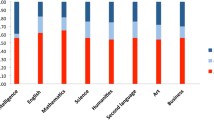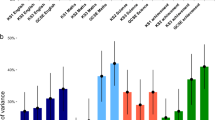Abstract
Understanding the etiology and relationship between standardized intelligence and academic achievement tests is essential, given their ever-increasing role in American education. Behavioral genetic studies have examined the genetic and environmental etiology of intelligence, academic achievement, and their relationship. Results suggest that genetic, shared environmental, and nonshared environmental influences have an impact on intelligence and academic achievement. Behavioral genetic studies also suggest that the importance of genes may vary as a function of age. Other studies suggest that genes drive the correlation and that the nonshared environment drives the discrepancy between measures of intelligence and achievement. Implications for the identification of intellectually and academically relevant environmental influences are discussed.
Similar content being viewed by others
REFERENCES
Baker, L. A., Treloar, S. A., Reynolds, C. A., Health, A. C., and Martin, N. G. (1996). Genetics of educational attainment in Australian twins: Sex differences and secular changes. Behav. Gen. 26(2): 89-102.
Binet, A., and Simon, T. (1905). Mithodes noevelles por le diagnostic du niveau intellectual des anormaut (new methods for the diagnosis of intellectual abnormalities. L'Annee Psycholog 11: 191-244.
Bouchard, T. J., Jr., and McGue, M. (1981). Familial studies of intelligence: A review. Science 212: 1055-1059.
Briggs, C., and Elkind, D. (1977). Characteristics of early readers. Percep Mot Skills 44: 1231-1237.
Brody, N. (1992). Intelligence (2nd ed.). Academic Press, New York.
Brody, N. (1997). Intelligence, schooling, and society. Am. Psych. 52(10): 1046-1050.
Brooks, A., Fulker, D. W., and DeFries, J. C. (1990). Reading performance and general cognitive ability: A multivariate genetic analysis of twin data. Person. Indiv. Diff. 11: 141-146.
Butler, S. R., Marsh, H. W., Sheppard, M. J., and Sheppard, J. L. (1985). Seven-year longudinal study of the early prediction of reading achievement. J. Edu. Psych. 77: 349-361.
Campbell, F. A., and Ramey, C. T. (1994). Effects of early intervention on intellectual and academic achievement: A follow-up study of children from low income families. Child Dev. 65: 684-698.
Cardon, L. R., Smith, S. D., Fulker, Kimberling, W. J., Pennington, B. F., and DeFries, J. C. (1994). Quantitative trait locus for reading disability on Chromosome 6. Science 266: 921-923.
Carroll, J. B. (1993). Human Cognitive Abilities. Cambridge University Press, New York.
Ceci, S. J., and Williams, W. M. (1997). Intelligence, schooling, and income. Am. Psych. 52: 1051-1058.
Chipuer, H. M., Rovine, M. J., and Plomin, R. (1990). LISREL modeling: Genetic and environmental influences on IQ revisited. Intelligence 14: 11-29.
Chorney, M. J., Chorney, K., Seese, N., Owen, M. J., Daniels, J., McGuffin, P., Thompson, L. A., Detterman, D. K., Benbow, C., Lubinski, D., Eley T., and Plomin, R. (1998). A quantitative trait locus associated with cognitive ability in children. Psych. Sci. 9(3): 159-166.
Dunn, N. E. (1981). Children's achievement at school-entry age as a function of mothers' and fathers' teacher sets. Elem. School J. 81: 245-253.
Field, L., and Kaplan, B. J. (1998). Absence of linkage of phonological coding dyslexia to Chromosome 6p23-p21.3 in a large family data set. American J. Hum. Gen. 63: 1448-1456.
Finkel, D., Pedersen, N L., Plomin, R and McClearn, G. E. (1998). Longitudinal and cross-sectional twin data on cognitive abilities in adulthood: The Swedish Adoption/Twin Study of Aging. Dev. Psych. 34: 1400-1413.
Fisher, S. E., Marlow, A. J., Lamb, J., Maestrini, E., Williams, D. F., Richardson, A. J., Weeks, D. E., Stein, J. F., and Monaco, A. P. (1999). A quantitative-trait locus on chromosome 6p influences different aspects of developmental dyslexia. Am. J. Hum. Gen 64: 146-156.
Flynn, J. R. (1998). IQ gains over time: Toward finding the causes. In Neisser, U. (ed.) The Rising Curve. Washington: American Psychological Association.
Gardner, H. M. (1983). Frames of Mind: A Theory of Multiple Intelligences. Basic Books, New York.
Gayan, J., Smith, S. D., Cherny, S. S., Cardon, L. R., Fulker, D. W., Brower, A. M., Olson, R. K., Pennington, B. F., and DeFries, J. C. (1999). Quantitative-trait locus for specific language and reading deficits on chromosome 6p. Am. J. Hum. Gen. 64: 157-164.
Ge, X., Conger, R. D., Cadoret, R. J., Neiderhiser, J. M., Yates, W., Troughton, W., and Stewart, M. A. (1996). The developmental interface between nature and nurture: A mutual influence model of child antisocial behavior and parenting. Dev. Psych. 32: 574-589.
Gill, C. E., Jardine, R., and Martin, N. G. (1985). Further evidence for genetic influences on educational achievement. Br. J. Edu. Psych. 55: 240-250.
Grigorenko E. L., Wood F. B., Meyer M. S., Hart L. A., Speed W. C., Shuster A., and Pauls D. L. (1997). Susceptibility loci for distinct components of developmental dyslexia on chromosomes 6 and 15. Am. J. Hum. Gen. 60(1): 27-39.
Harris, J. R. (1995). Where is the child's environment? A group socilization theory of development. Psych. Rev. 102(3): 458-489.
Hetherington, E. M., Reiss, D., and Plomin, R. (eds.) (1994). Separate Social Worlds of Siblings: Impact of Nonshared Environment on Development. Lawrence Erlbaum, Hillsdale, NJ.
Husen, T. (1959). Psychological Twin Research. Almquist & Wiksell, Stockholm.
Jencks, C. (1979). Who Gets Ahead? The Determinants of Economic Success in America. Basic Books, New York.
Lichtenstein, P., and Pedersen, N. L. (1997). Does genetic variance for cognitive abilities account for genetic variance in educational achievement and occupational status? A study of twins reared apart and twins reared together. Soc. Biol. 44: 77-90.
Loehlin, J. C., and Nichols, R. C. (1976). Heredity. Environment. and Personality. University of Texas Press, Austin.
Lonigan, C. J. (March, 1993). Somebody Read Me a Story: Evaluation of a Shared Reading Program in Low-IncomeDaycare. Presented at the Society for Research in Child Development symposium on interventions in shared reading for children from low-income families. New Orleans, LA.
Mason, J. M. (1992). Reading stories to preliterate children: A proposed connection to reading. In Gough, P. B. Ehri, L. C. and Treiman, R. (eds.). Reading Acquisition. Lawrence Erlbaum Assoc., Hillsdale, NJ. pp. 215-241.
McCall, R. B., Evahn, C., and Kratzer, L. (1992). High School Underachievers: What Do They Achieve as Adults? Sage, London, England.
McClearn, G. E., Johansson, B., Berg, S., Pedersen, N. L., Ahern, F., Petrill, S. A., and Plomin, R. (1997). Substantial genetic influence on cognitive abilities in twins 80 or more years old. Science 276: 1560-1563.
McGue, M., Bouchard, T. J., Jr., Iacono, W. G., and Lykken, D. T. (1993). Behavioral genetics of cognitive ability: A lifespan perspective. In Plomin, R. and McClearn, G. E. (Eds.). Nature, Nurture, and Psychology. Washington, DC: American Psychological Association.
Moon, C., and Wells, G. (1979). The influence of home on learning to read. J. Res. Read. 2: 53-62.
Pike, A., McGuire, S., Hetheringon, E. M., Reiss, D., and Plomin, R. (1996). Family environment and adolescent depressive symptoms and antisocial behavioral: A multivariate genetic analysis. Dev. Psych. 32(4): 590-603.
Pike, A., Reiss, D., Hetherington, E. M., and Plomin, R. (1996). Using MZ differences in the search for nonshared environmental effects. J. Child Psych. Psychi. 37(6): 695-704.
Plomin, R. (1986). Development, Genetics, and Personality. Erlbaum, Hillsdale, NJ.
Plomin, R. (1988). The nature and nurture of cognitive abilities. In Sternberg, R. J. (ed.), Advances in the Psychology of Human Intelligence. Erlbaum, Hillsdale, NJ, (pp. 1-33).
Plomin, R., and Bergeman. C. S. (1991). The nature of nurture: Genetic influence on ''environmental'' measures. Behav. Brain Sci. 14: 373-427.
Plomin, R., DeFries, CJ. C., McClearn, G. E., and Rutter, M. (1997). Behavioral Genetics (3rd ed.). Freeman, New York.
Plomin, R., Fulker, D. W., Corley, R., and DeFries, J. C. (1997). Nature, nurture, and congnitive development from 1 to 16 years: A parent-offspring adoption study. Psych. Sci. 8(6): 442-447.
Plomin, R., and Petrill, S. A. (1997). Genetics and intelligence: What's new? Intelligence. 24(1): 53-78.
Ramey, C. T., and Campbell, F. A. (1991). Poverty, Early Childhood Education and Academic Competence. The Abecedarin Project. Cambridge University Press, Cambridge, England.
Rowe, D. C. (1994). The Limits of Family Influence: Genes, Experience, and Behavior. Guilford Press, New York.
Rowe, D. C, and Rodgers, J. L. (1997). Poverty and behavior: Are environmental measures nature and nurture? Dev. Rev. 17(3): 358-375.
Sattler, J. M. (1988). Assessment of Children (3rd ed.). Jerome M. Sattler, San Diego.
Scarborough, H. S. (1991). Antecedents to reading disability: Preschool language development and literacy experiences of children from dyslexic families. Read. Writ. 2: 221-233.
Scarborough, H. S. (1998). Early identification of children at risk for reading disabilities: Phonological awareness and some other promising predictors. In Shapiro, B. K. Accardo, P. J. and Capute, A. J. (eds.), Specific Reading Disability: A View of the Spectrum. York Press, Timonium, MD, pp. 75-119.
Scarboruogh, H. S., and Dobrich, W. (1994). On the efficacy of reading to preschoolers. Dev. Rev. 14: 245-302.
Scarr, S., and McCartney, K. (1983). How people make their own environments: A theory of genotype-environment effects. Child Dev. 54: 424-435.
Spearman, C. (1904). ''General intelligence,'' objectively determined and measured. Am. J. Psych. 15: 201-293.
Spitz, H. H. (1986). The Raising of Intelligence: A Selected History of Attempts to Raise Retarded Intelligence. Lawrence Erlbaum, Hillsdale, NJ.
Sternberg, R. J. (1985). Beyond IQ: A Triarchic Theory of Human Intelligence. Cambridge University Press, New York.
Terman, L. M. (1916). The Measurement of Intelligence. Houghton-Mifflin, Boston.
Thompson, L. A., Detterman, D. K., and Plomin, R. (1991). Associations between cognitive abilities and scholastic achievement: Genetic overlap but environmental difference. Psych. Sci. 2: 158-165.
Thurstone, L. L. (1938). Primary mental abilities. Psychomet. Monog. No. 1.
van den Oord, E. J. C., and Rowe, D. C. (1997). An examination of genotype-environment interactions for academic achievement in a U.S. national longitudinal survey. Intelligence 25(3): 205-228.
Wadsworth, S. J. (1994). School achievement. In DeFries, J. C. Plomin, R. and Fulker, D. W. (eds.). Nature and Nurture During Middle Childhood. Blackwell, Cambridge, MA, pp. 86-101.
Wechsler, D. (1939). The Measurement of Adult Intelligence. Williams & Wilkins, Baltimore.
Whitehurst, G. J., Falco, F. L., Lonigan, C. J., Fischel, J. E., DeBaryshe, B. D., Valdez-Menchaca, M. C., and Caulfield, M. (1988). Accelerating language development through picture book reading. Dev. Psych. 24: 552-559.
Author information
Authors and Affiliations
Rights and permissions
About this article
Cite this article
Petrill, S.A., Wilkerson, B. Intelligence and Achievement: A Behavioral Genetic Perspective. Educational Psychology Review 12, 185–199 (2000). https://doi.org/10.1023/A:1009023415516
Issue Date:
DOI: https://doi.org/10.1023/A:1009023415516




